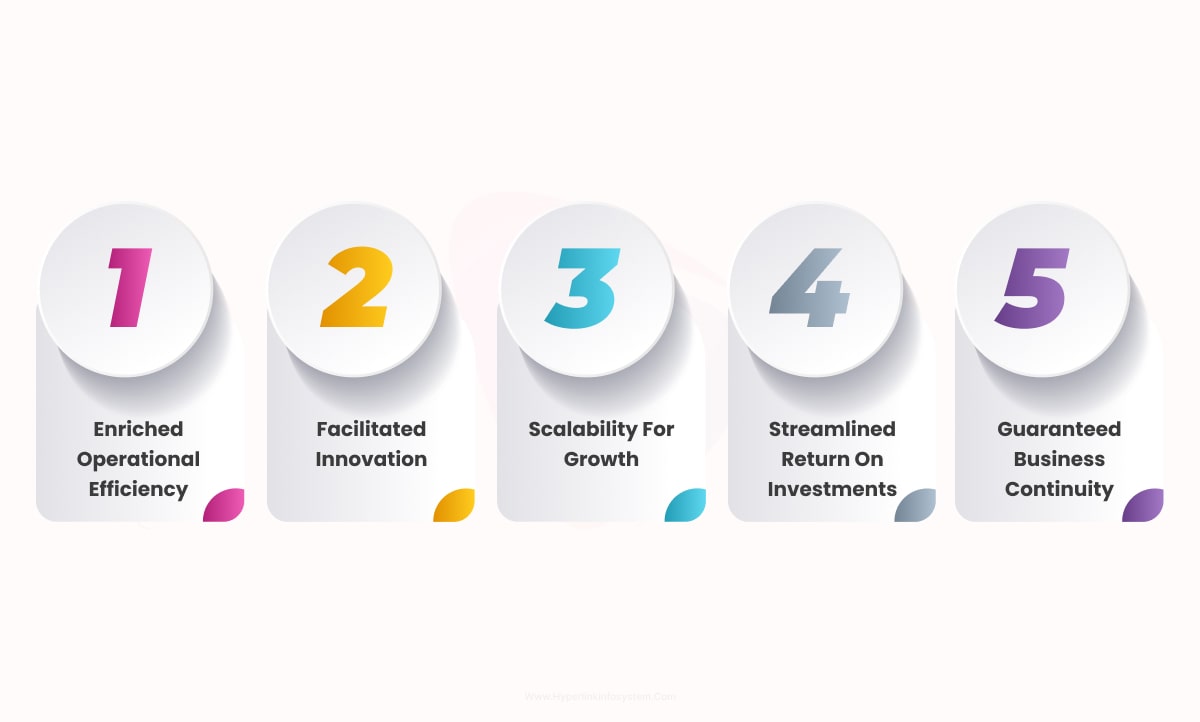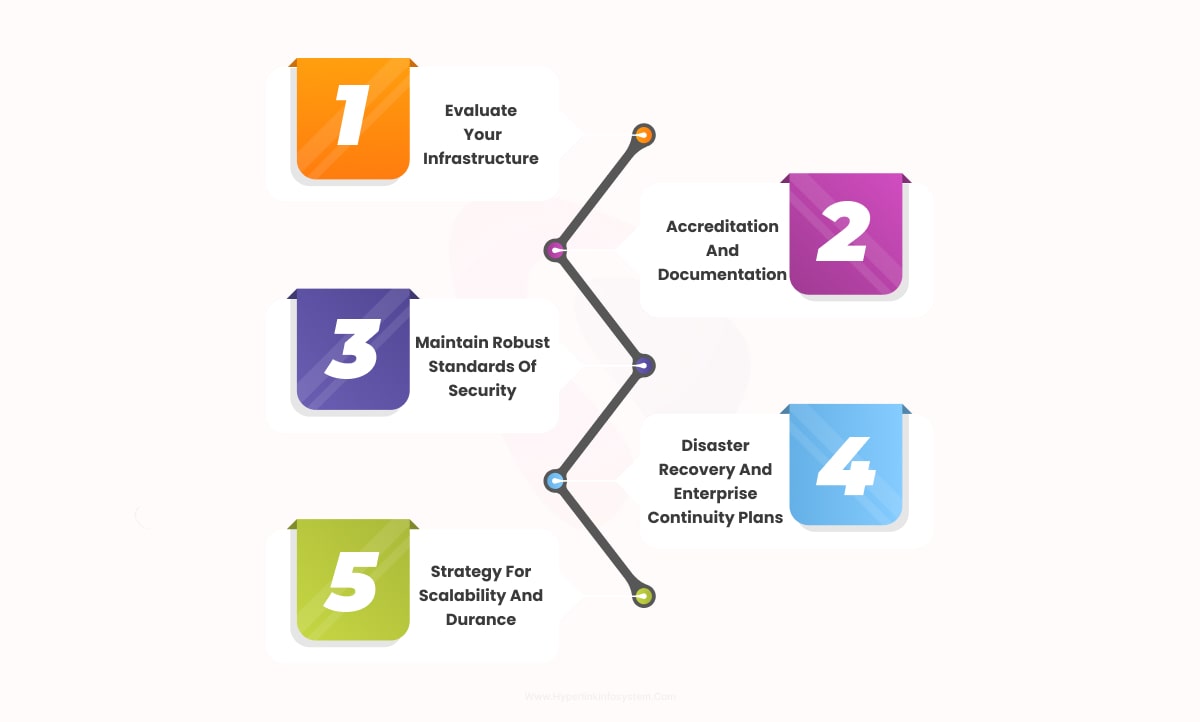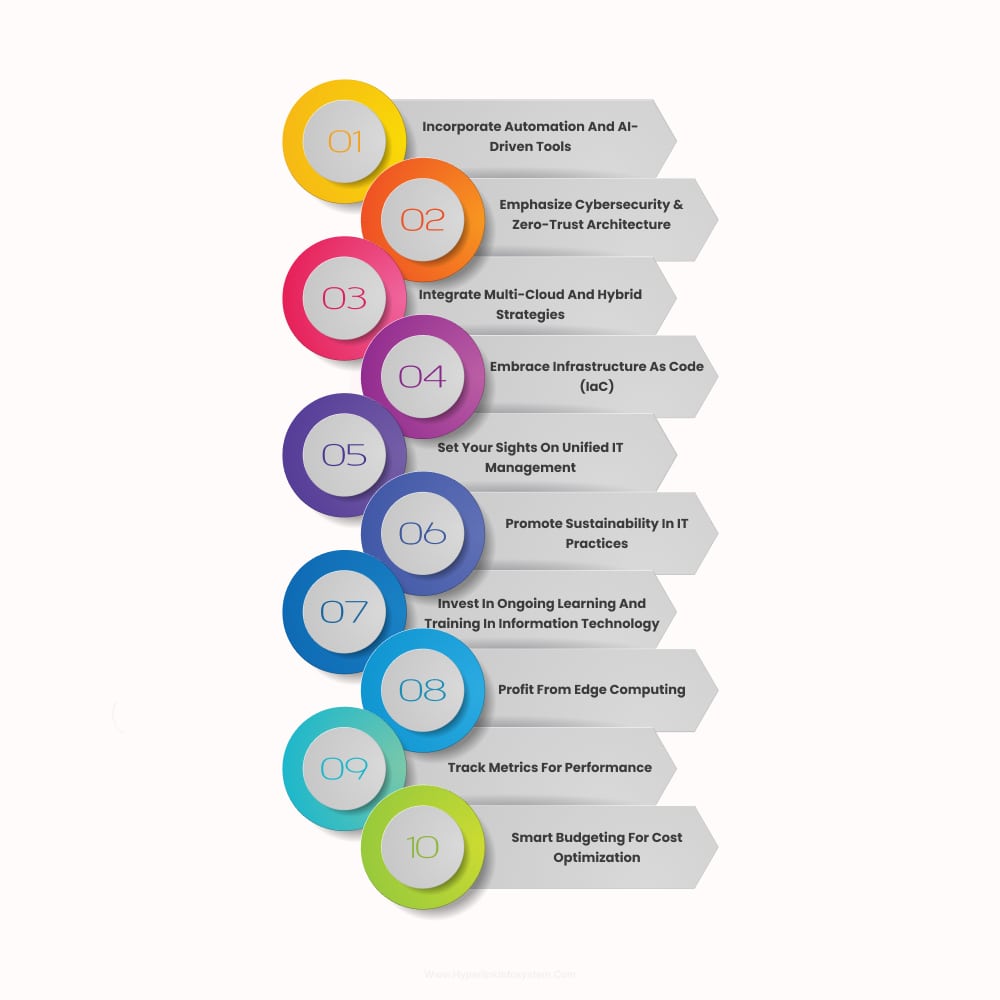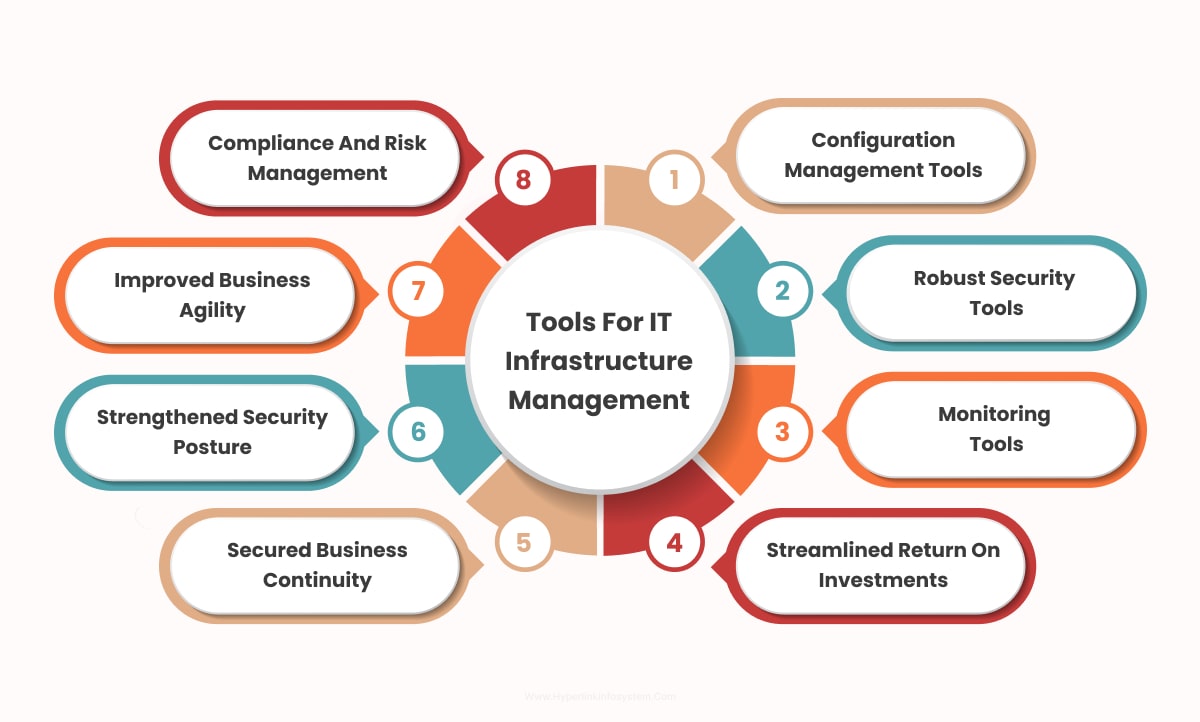
Introduction
In a world where everything is pretty much digital and automated, effective IT infrastructure management is the key to reliability and efficiency among enterprises. Having an IT infrastructure that evolves as you grow isn't just a support-based functionality but a strategic asset that sustains you in the long term. This underlies many modern business activities, including IoT, blockchain, artificial intelligence, and machine learning, as well as essential company operations such as customer relationship management and data storage. Effective IT infrastructure management is very important if you want to maintain your business's continuity, minimize unnecessary downtime, maximize uptime, and optimize overall ROI.
In 2025, a good IT infrastructure is pretty much the backbone of modern enterprise. Whether you need to ensure streamlined operations or drive innovation, effective IT infrastructure management is the key to success and agility. However, it's important to note that it's not a viable option to perform without a robust IT infrastructure management system backing your every move. You should approach a competent IT consulting services provider that can assist you in aligning IT strategy with your business goals. This includes maintaining optimal security and effectively monitoring resource allocation in an ever-changing technological world. Many small and medium-sized business leaders underestimate their IT needs, and we're to change this misconception.
Every business, no matter what the size, needs a mighty IT infrastructure to thrive. In this blog, we're going to enlighten you with a detailed analysis and knowledge stanzas that'll help you understand IT ecosystems and how IT infrastructure development actually works. After reading this article, you'll be good to go on everything you need to know about the best practices and strategies enterprises can adopt for facilitating effective IT infrastructure management. Whether you're changing that good old legacy system, implementing robust cybersecurity measures, or just enhancing network performance, our valuable insights will help you move toward an IT ecosystem that's resilient and future-ready.
What is IT Infrastructure Management?
Many thriving organizations currently rely on proactive and efficient IT ecosystems to drive their business operations. IT infrastructure is an essential component for any company's success, and effective IT infrastructure management leads to the most immaculate operational performance you've ever witnessed. IT infrastructure plays a key role in any company's success, which entails mainly hardware, software, networks, and data centers. These components sustain everything from primary corporate applications to employee interactions. Robust IT infrastructure management enables you to have optimal performance, low issues in security, perfect compliance, and fewer disruptions. It also emphasizes different strategies for management process streamlining and developing a rugged, adaptive IT foundation.
In the past few years, IT infrastructure management services have matured in tandem with technological advancements. IT Infrastructure management is now recognized as more than just a support system for enterprises but also includes the control of the elements needed for diverse technological activities. It also covers wireless, wired setups, network management, administration, and storage management. Most IT consulting services believe in establishing strong strategies to leverage best-in-class management solutions for a result-oriented conclusion. Your IT infrastructure management team in any enterprise takes care of these products, services, and components:
- Software investments
- Asset lifecycle
- Utilization of Network
- Storage
- Hardware procurement
- Product (actual and virtual availability)
- Overall energy consumption
- Carbon footprint
- Physical and virtual assets
- Capacity monitoring/planning
- Amenities (Data Center Infrastructure Management)
- Servers
- Wireless and wired network operations
- Software
- Hardware
- Mobile connectivity
- Security (malware/virus protection)
- Maintenance/service updates
- Routers
- Management Tools
- Monitoring Tools
Putting it simply, IT infrastructure management assures that every tech component of the company is functioning correctly. IT Infrastructure Management is the foundation base of any organization's IT system; metaphorically speaking, it's the sunscreen of your brand. But why is IT infrastructure development and management so important for modern businesses? Well, for starters, the level of efficiency is incredible due to the perfect sync of hardware and software leading to clockwork-style operational performance. During any major crisis, there's a robust incident management plan to keep things going. Good IT infrastructure management provides top-tier protection against cyber attacks and assures total data encryption. In contrast, business agility prepares your IT infrastructure to implement new services, scale up operations, cope with evolving markets, and make informed choices utilizing real-time data. Finally, the application of advanced technologies like cloud-based solutions, artificial intelligence, and machine learning may accelerate the wheels of innovation without requiring major upfront expenditures in physical infrastructure. So now the question remains: what are the benefits?
Benefits Of IT Infrastructure Management in 2025
As enterprises traverse the intricacies of the IT ecosystems, effective IT infrastructure management has become an instrumental solution for propelling development and achieving operational excellence. The benefits of IT Infrastructure Management, in 2025 concern the following areas:

Enriched Operational Efficiency
ITIM, an acronym for IT infrastructure management, uncomplicates IT resource management, which enables enterprises to track and monitor their systems proactively. It will further help in reducing operational bottlenecks and downtime by encouraging the crew to prioritize their primary duties without interruptions that occur due to technical interruptions. Additionally, automation solutions enhance employee productivity by fostering cross-departmental collaboration and resource allocation.
Facilitated Innovation
Effective IT infrastructure management allows your IT teams to refocus their priorities from mundane maintenance towards the path of innovation. This fosters an environment of creative culture where teams feel free to experiment with new age and emerging technologies such as artificial intelligence, machine learning, and the Internet of Things (IoT), accelerating enterprise digital transformation and taking companies ahead of the digital curve.
Scalability for Growth
As companies grow with time and user base, their IT infrastructure should also be proactively growing with them. IT infrastructure management renders the needed flexibility to manage rising workloads and encourage all-around growth while having no compromise on performance and user experience. You should definitely consider cloud-based solutions for enabling top-notch business scalability.
Streamlined Return on Investments
Investing in IT infrastructure may be costly; however, proper management ensures that these assets are fully utilized, reducing waste and needless costs. Organizations may increase their return on technology expenditures by maintaining system performance and eliminating costly downtime.
Guaranteed Business Continuity
IT Infrastructure management incorporates proactive methods to reduce downtime during crises, ensuring that activities continue smoothly even under difficult situations. This element is crucial for ensuring service delivery and securing sensitive data.
Best Practices in Optimizing Your IT Infrastructure
There's a lot of market talk about AWS vs. Azure vs. Google Cloud, or what's the best tool for using artificial intelligence and machine learning, or should you even consider DevOps services, but before all of that, let's answer the bigger question: How to improve IT infrastructure management and what are the best practices to implement.

Evaluate Your Infrastructure
If your company has a smart and proactive IT infrastructure development team, they'll be on alert and periodically assess your already existing infrastructure. This isn't just a one-time project; it's forever ongoing and continual with time, age, trends, and investment. Infrastructures tend to become obsolete if they aren't updated over time; hence, start the performance assessment by asking yourself the following questions:
- How is our current system fairing with the competition?
- What are the specific areas for improvement?
- How are the areas getting impacted according to time and productivity?
- What's performing well, and what's going on at a good pace for our company?
- Are there regions or processes you can duplicate?
- What can be done to improve these processes, and how can it happen?
Your IT infrastructure managers will be responsible for evaluating each and every aspect of the infrastructure, big or small. Let's take, for instance, if your IT Infrastructure management team conducts due diligence and realizes that the existing systems have become outdated and the company is in dire need of digital transformation. The IT manager's immediate next move would be to shift to cloud-based solutions for a variety of long-term benefits, including improved interoperability with computing resources, plausible alternatives for current back-office software, increased scalability, reduced resourcing costs, better capability to handle big amounts of data from multiple sources, and implementing technologies that enrich business operations like AI/ML, IoT, and others. After your team has identified infrastructure aspects that could use a makeover, it's time to curate a well-thought-out strategy roadmap.
Accreditation and Documentation
It's imperative rather than mandatory to standardize your hardware, software, and documentation. This helps in the effective management of your IT infrastructure. Standardizing your operations and other setups uncomplicates the administration and fosters prompt troubleshooting. Additionally, documenting your company's setups helps your team members retain uniformity and simplify other activities. Having a standardized approach makes it convenient for employees to locate and tackle any difficulties, and they don't have to sort each segment and regulate its intricacies. IT Infrastructure management teams effectively help reduce complications and improve IT process management by sustaining endless consistency and responding proactively. Big businesses with diverse systems often find standardization to be indispensable for confirming interoperability. Having structured and configured documentation also aids in eliminating any third-party integration concerns and secures streamlined internal operations and communications. Clear documentation renders a proper point of reference for team associates and further reduces downtime while also being utilized for audits and compliance in the future.
Maintain Robust Standards of Security
Whenever you're discussing the IT infrastructure development enhancements of any company, security requirements are always on top of the funnel. Whether it's protecting user data or confiding encryption among end users, enterprises have to ensure an optimal level of cybersecurity while delivering remote employment opportunities. Some of the most commonly observed cybersecurity risks are:
- Social engineering
- IoT attacks
- Cyber-physical attacks
- Ransomware attacks
- Phishing
- Crypto-jacking
- State-sponsored attacks
If you’re looking for a tool to help you develop a customized cybersecurity strategy, the Federal Communications Commission (FCC) offers an online cyber planner tool for about everything related to fraudulent threat prevention. However, it’s important to note that this resource provided by FCC is mainly targeted toward small businesses and shall not be suitable for enterprise-level firms. You can also utilize strategies like internal audits if you’re using a cloud service provider, periodically upgrade your disaster recovery plan to reduce downtime effects and stay on top of industry cybersecurity trends while retaining adherence to best practices. Also, ensure that your antivirus and antispyware are updated with new installations or updates, monitor computer access changes or in the network, and lastly, train all your employees about the principles of cybersecurity and best practices for addressing the vitality of secured Wi-Fi networks.
Disaster Recovery and Enterprise Continuity Plans
Retaining a powerful disaster recovery strategy doesn't just accelerate your organization's recovery process but also makes sure that the pioneering services are running without any interference. A disaster recovery strategy is kind of the heart and soul of any IT infrastructure management system's resiliency. Incorporating this practice enables you to quickly recover from natural catastrophes, failures in hardware, cyber attacks, and power outages. This assists you in conducting complete risk assessments, adhering to stringent protocols, frequent data backups, upgrading technologies for swift IT system restoration, and more. With an absence of this coverage, you could experience data loss and lengthy downtime, which would ultimately affect your IT operations and then profits. You also have to establish a robust business continuity plan; that’s part of the bigger plan to sustain operational functionality with the lowest possible disruptions. This technique also needs the creation of communication channels, maintained documentation, and stakeholder coordination. Disaster recovery and business continuity strategies aid enterprises in preserving their resilience and heavily minimizing downtime.
Strategy for Scalability and Durance
Having an endurance and scalability strategy in place is a vital segment in confirming that your IT infrastructure expands smoothly. Ask any cloud services management or DevOps services firm; they'll reinstate the above statement with utmost confidence. Scalability, or agility in tech terms, provides your in-house IT teams with a level of assurance and confidence that they can smoothly grow in response to the heightened demand or assistance for freshly introduced services and apps.
Strategy for capacity planning, on the other hand, concentrates on the availability of resources for fulfilling future business demands. This phase needs you to evaluate your present physical resources and their overall monthly/annual consumptions, implement plans for enhancing resource allocation, and anticipate future requirements. In 2025, there is a broad spectrum of available capacity management software options on the market to help you analyze trends, detect bottlenecks, acquire insights, and monitor firm performance. With the help of virtualization and public cloud services, companies can effectively decrease costs via dynamic resource modification for changing workloads and further increase performance proactiveness. Following these processes will help you to conveniently adapt to changing requirements while also supporting your business objectives.
Finally, ensuring regular updates and patches is a mandatory need if you wish to maintain a safe and stable IT system. Update fixes include bug fixing, remedying known vulnerabilities and flaws, reducing security risks, and improving the overall efficiency of the system. Having proper patch management systems in place helps in the automation of the downloading and deployment of updates, confirming that your apps and web solutions are always up to date. Collaboration and communication between the IT Infrastructure management team and other internal departments further improve infrastructure management and identify any potential organizational gaps.
Best Strategies for Effective IT Infrastructure Management in 2025
Businesses in 2025 will increasingly adopt new technologies such as artificial intelligence and machine learning, DevOps services, and cloud-based solutions, as well as undergo digital transformation, making IT infrastructure management an essential component of business continuity and sustainability. This shifting environs of tech demands modern tactics to keep enterprises competitive and agile. Let's break down some of the most successful IT infrastructure management strategies that'll make waves in 2025:

Incorporate Automation and AI-driven Tools
Automation, artificial intelligence, and machine learning are completely reshaping the world of IT administration by simplifying processes, boosting workforce productivity, and reducing human errors. Having automated monitoring tools by your side can help you detect and remedy issues before they happen. Next, it's time to infuse AI predictive analytics for assessing system usage trends, managing the allocation of resources, and forecasting faults in hardware. Finally, consider adding AI-powered self-healing systems for detecting and solving small issues automatically, diminishing downtime.
Emphasize Cybersecurity & Zero-trust Architecture
Cyberattacks have become pretty sophisticated in 2025; hence, having a robust security standard and policy is vital. Start by implementing a zero-trust approach that mandates tight identity verification for any person or even random devices attempting to access network resources. Next, focus on end-to-end encryption and multi-factor authentication (MFA) to secure every sensitive piece of data across each platform your product is present on. Performing regular vulnerability assessments and penetration testing will keep you on top of upcoming weaknesses and quick-fix them.
Integrate Multi-cloud and Hybrid Strategies
When it comes to cloud-based solutions, they’re pretty cost-effective and scalable in nature, but infusing multiple cloud computing services together enhances agility. With the hybrid cloud component, you can easily combine on-premise and cloud resources to balance accessibility, control, and affordability. You can also try the multi-cloud approach as a part of cloud services management to delegate workloads across diverse cloud providers for reduced reliance on a single source and increased redundancy.
Embrace Infrastructure as Code (IaC)
Infrastructure as Code facilitates the control of IT infrastructure via machine-readable scripts, which retain future-proofing and unification. Utilizing IaC technologies like Ansible or Terraform for continuously deploying and managing IT resources assures proper standardization. Implement version control and automate your infrastructure provisioning for faster deployments.
Set Your Sights on Unified IT Management
Centralizing IT administration across IT infrastructure management systems, apps, and networks guarantees quicker supervision. While unified platforms, help in monitoring and managing IT assets via consolidated dashboards. Utilizing tools that infuse application performance tracking, security, and network monitoring in just one interface. Lastly, ensure to motivate and enforce cooperation across IT, DevOps, and business groups for retaining optimal strategy.
Promote Sustainability in IT Practices
Sustainable IT infrastructure management isn't a trend anymore but an initiative for firms to lessen their environmental impact. You can start by investing in data center gear that is energy-efficient and employs renewable energy sources. For e-waste management, work on repurposing outdated IT equipment or discarding them properly. For optimal energy management, consider using sophisticated systems to monitor and reduce power usage.
Invest in Ongoing Learning and Training in Information Technology
Keeping IT personnel up to date on the newest technology is very essential for the best possible outcome. This guarantees that they can manage infrastructure efficiently. Next, you can add programs for upskilling by providing training on emerging technologies such as cybersecurity, cloud computing, artificial intelligence, and machine learning. Encouraging team certifications for gaining industry-recognized credentials is always a good idea. Also, consider hosting frequent workshops and seminars for brainstorming emerging trends and tactics in IT infrastructure development.
Profit from Edge Computing
Edge computing has become a major game changer in the IT infrastructure management system, especially after the growing demands for IoT and real-time applications. To reduce latency, you need to process data closer to the source for quicker responses in real-time applications. Distributing workloads more effectively between edge devices and central data centers will heavily impact enriching scalability. Lastly, enabling localized processing lowers the dependency on centralized systems.
Track Metrics for Performance
Real-time insights are important to confirm the peak performance of your organization’s IT assets. Primary metrics include user satisfaction, resource consumption, latency, and uptime. For monitoring, better consider using performance dashboards like Datadog, Splunk, or SolarWinds to consolidate performance data. Regular reporting to stakeholders will further ensure that your IT performance aligns with business objectives, always.
Smart Budgeting for Cost Optimization
Budget management is a critical component of any good IT infrastructure management. You can start your resource optimization by conducting regular audits of resource consumption for waste reduction. For the cost-benefit analysis, you need to determine the ROI of IT expenditures before deployment occurs. Make sure to keep track of your SaaS subscriptions to avoid extra payments for resources you won't use.
Tools for IT Infrastructure Management
The optimization of your IT infrastructure management system calls for the complete utilization of top-tier tools and technologies. This includes automating processes, streamlining workflows, and gaining an enlightened understanding of the health and performance of your system. Let’s break down some of the necessary tools you might need for your IT infrastructure management.

Configuration Management Tools
Configuration management tools or solutions help simplify the server, software, and network device setup and provisioning. These tools help organizations retain consistency and ease the deployment and maintenance operations while lowering the chances of human errors. Configuration management solutions can also assist in tracking modifications to your IT infrastructure, leading to convenient troubleshooting and reducing configuration drift.
Robust Security Tools
Security solutions help organizations secure critical data and IT infrastructure. This also includes a broad spectrum of tools and technologies, such as anti-malware software, network firewalls, vulnerability management tools, and intrusion detection and prevention systems.
Monitoring Tools
Security measures are the most important part of monitoring tools, whether it's AWS vs. Azure vs. Google Cloud or basically any cloud computing service. It helps you attain constant insight into the performance and health of your IT infrastructure. This entails components such as networks, applications, storage devices, and servers. These programs are devised to collect data about resource utilization, network traffic, CPU load, memory usage, and other mandated protocols. These can generate instant notifications for potential issues or abnormalities, allowing for a prompt response.
Streamlined Return on Investments
Infrequent or late investments in IT infrastructure have proven very costly in the past. Although proper management confirms that all the assets are utilized optimally, lowering the amount of waste and unnecessary costs. Organizations get the liberty to increase their return on technology expenses by maintaining system performance and eliminating costly downtime.
Secured Business Continuity
IT Infrastructure Management incorporates a bundle of proactive methods and strategies helpful in reducing downtime during crises, confirming that all operations run smoothly even in the most difficult situations. This component is important for maintaining optimal delivery of services and securing sensitive data.
Strengthened Security Posture
Cyber risks are increasing daily in 2025; having a proactive IT infrastructure management system guarantees that companies have strong security measures set in place like firewalls and constant monitoring. This strategy helps in securing confidential data and also helps in maintaining compliance with severe data protection standards, further reducing data breach chances and legal concerns.
Improved Business Agility
In an ever-changing corporate environment, IT Infrastructure management helps your organization to respond quickly to any kind of market fluctuations and client expectations. Companies can easily retain a huge chunk of competitive edge and operational continuity by enabling the rapid deployment of new apps and seamless scaling of current operating systems.
Compliance and Risk Management
Companies that boast a good IT infrastructure management plan possess much successful retaliation towards negotiating difficult regulatory environments. Not only will this help you showcase your dedication toward your ethical procedures and data privacy, but it will also enhance your organization's reputation by preventing unnecessary legal issues.
Conclusion
In the end, comprehending the rudimentary elements of IT infrastructure management will spread the base for developing successful strategies and solutions. Effective IT infrastructure management is essential for guaranteeing the success of next-gen organizations. By implementing the best practices and strategies highlighted above, companies can effortlessly adapt to swiftly changing business demands and market shifts. Following this will help you streamline your IT operations, eradicate mundane manual tasks, and enhance overall productivity. Reduce operating expenses by optimizing resource usage, minimizing downtime, and improving cyber security and compliance with industry requirements. Enterprises that adopt an aggressive and strategic plan for IT infrastructure management can lay down a solid basis for digital transformation and succeed in their business ambitions.
Implementing a software management system for governing your cloud-based solutions and driving innovation needs a reliable partner, to begin with. Whether you are a booming enterprise or an established conglomerate, possessing a well-managed IT infrastructure catalyzes accomplishing your business pursuits and upholding long-term success. That's where we step in. Hyperlink InfoSystem has been a trusted IT solutions partner since 2011, curating some of the most bespoke IT infrastructure management system solutions for a wide range of industries. With over 2700+ happy clients and a whopping 98% client retention rate, the company boasts over 1250+ dedicated developers with mastery in diverse programming languages to bring your vision to life. Whether you're wondering about AWS vs. Azure vs. Google Cloud DevOps services or cloud-based solutions, our IT consulting services are designed to cater to your every need. Connect with us today to understand how we can help your enterprise.
FAQs
Q- What is IT infrastructure management, and why is it important for enterprises?
Ans- IT infrastructure management comprises mainly monitoring and managing an organization's in-house hardware, software, networks, and services. This helps in fostering a culture of business continuity, operational efficiency, and alignment with corporate objectives.
Q- What are the three primary components of an IT infrastructure?
Ans- The three primary components of an IT infrastructure are:
- Hardware: This includes physical equipment like laptops, servers, computers, and storage systems.
- Software: This entails operating systems, management tools, multiple programs, and applications.
- Network: This refers to different connection components, such as communication protocols, switches, regulators, routers, and basically, products that foster streamlined data transmission within the intricate IT system.
Q- What are the common issues in performance that are encountered with an IT infrastructure?
Ans- The IT infrastructure management system encounters many common performance issues, such as:
- Inadequate storage in data
- Counterproductive data management
- Budgetary constraints in tech innovation investments
- Undersupply of robust computing systems
- Cyberthreats
- Periodic updates and maintenance
- Unsecured endpoints
- Inutile cost management
Q- How can enterprises ensure seamless IT infrastructure scalability?
Ans- IT ecosystems that are looking for cloud services management or cloud-based solutions can conveniently scale their IT infrastructure for the modern market. Other things you can implement are automating resource provisioning and load balancers for enhanced enterprise future-proofing.
Q- What are the IT infrastructure management best practices you need to implement in 2025?
Ans- Some of the popular IT infrastructure management best practices you need to implement in 2025 are:
- Embrace cloud-native strategies
- Integrate on-premises infrastructure with public and private clouds
- Ensure robust cloud security measure
- Utilize AI/ML for IT Operations (AIOps)
- Use tools like Terraform and Ansible for optimal Infrastructure as Code (IaC)
- Implement a zero-trust security model and comply with GDPR and CCPA regulations
- Deploy robust monitoring and log management systems
Q- What security measures are in place to protect your IT infrastructure?
Ans- Some popular examples of security measures include frequent software and hardware upgrades, robust access restrictions, risk assessments, and security audits. Other things to implement in your organization are proper training in tools utilization, intrusion detection systems, deploying firewalls, and encrypting all sensitive data. Extra protection measures include secure email gateways, anti-virus software, sandboxing, URL filtering, response (EDR) solutions, and endpoint detection.



















